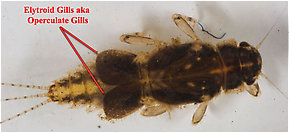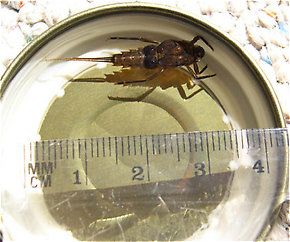Blog & Latest Updates
Fly Fishing Articles
Insects by Common Name


Mayfly Genus Neoephemera
Taxonomic Navigation -?-
Kingdom
Animalia (Animals)
» Phylum
Arthropoda (Arthropods)
» Class
Insecta (Insects)
» Order
Ephemeroptera (Mayflies)
» Family
Neoephemeridae
» Genus Neoephemera
4 species aren't included.
Where & When
Region: East
Neoephemera seems to be most common in the Southeast, although there are scattered distribution records across parts of the Midwest and Northeast. The one specimen on this site hatched in mid-late May.Nymph Biology
Neoephemera mayfly nymphs look like overgrown Caenis nymphs, with the characteristic operculate (

The operculate gills of a Caenis nymph.
Pictures of 1 Mayfly Specimen in the Genus Neoephemera:
Neoephemera Mayfly Nymph View 7 PicturesThis specimen was sent to me for identification by Caleb Boyle, who did such a good job taking pictures of his mystery mayfly that, after identification, I asked him for permission to add it to this site, which he granted. This is great luck, since Neoephemera is a rare mayfly and it's unlikely I would ever have collected a specimen for the site myself.
View 7 PicturesThis specimen was sent to me for identification by Caleb Boyle, who did such a good job taking pictures of his mystery mayfly that, after identification, I asked him for permission to add it to this site, which he granted. This is great luck, since Neoephemera is a rare mayfly and it's unlikely I would ever have collected a specimen for the site myself.
Caleb collected it in mid-late May of 2004 either McDowell County or Ashe County in North Carolina, in a riffle less than two feet deep in a cold trout stream. He reared the nymph into a dun, whose wings appear in one of the photos below. He describes the specimen as follows:
I don't know to which species it belongs, but its size rules out the most common one in the genus, Neoephemera bicolor. It matches the size of Neoephemera purporea so that is a likely other possibility, but there are two other candidate species (Neoephemera compressa and Neoephemera youngi) about which I have no information, so I can't rule them out.
Disregard the camera, region, and exact date listed on these photos. I still need to update the site to accommodate user contributions which don't use my equipment.
 View 7 PicturesThis specimen was sent to me for identification by Caleb Boyle, who did such a good job taking pictures of his mystery mayfly that, after identification, I asked him for permission to add it to this site, which he granted. This is great luck, since Neoephemera is a rare mayfly and it's unlikely I would ever have collected a specimen for the site myself.
View 7 PicturesThis specimen was sent to me for identification by Caleb Boyle, who did such a good job taking pictures of his mystery mayfly that, after identification, I asked him for permission to add it to this site, which he granted. This is great luck, since Neoephemera is a rare mayfly and it's unlikely I would ever have collected a specimen for the site myself. Caleb collected it in mid-late May of 2004 either McDowell County or Ashe County in North Carolina, in a riffle less than two feet deep in a cold trout stream. He reared the nymph into a dun, whose wings appear in one of the photos below. He describes the specimen as follows:
Nymph exoskeleton:
Body: 16-17mm
Tails: 3, equal length, 13mm
Found on the surface of the water. The gill cover covers ab. segments 3-5.
Subimago (Subimago: Mayfly nymphs emerge from the water into subimagoes, better known to anglers as "duns." They are a sexually immature, winged, recognizably adult stage and they must molt one more time into imagoes or "spinners" before they can mate.):
Body: 16mm, dark brown/ olive
Tails: 3, equal length, 14mm
Wings: dark slate color, large hind wings.
I don't know to which species it belongs, but its size rules out the most common one in the genus, Neoephemera bicolor. It matches the size of Neoephemera purporea so that is a likely other possibility, but there are two other candidate species (Neoephemera compressa and Neoephemera youngi) about which I have no information, so I can't rule them out.
Disregard the camera, region, and exact date listed on these photos. I still need to update the site to accommodate user contributions which don't use my equipment.
Collected May 20, 2004 from unknown in North Carolina
Added to Troutnut.com by Troutnut on March 20, 2007
Added to Troutnut.com by Troutnut on March 20, 2007
Your Thoughts On Neoephemera:
Top 10 Fly Hatches
Top Gift Shop Designs
Eat mayflies.
Top Insect Specimens
Miscellaneous Sites
Troutnut.com is copyright © 2004-2024 Jason
Neuswanger (email Jason). See my FAQ for information about use of my images.
 privacy policy
privacy policy
